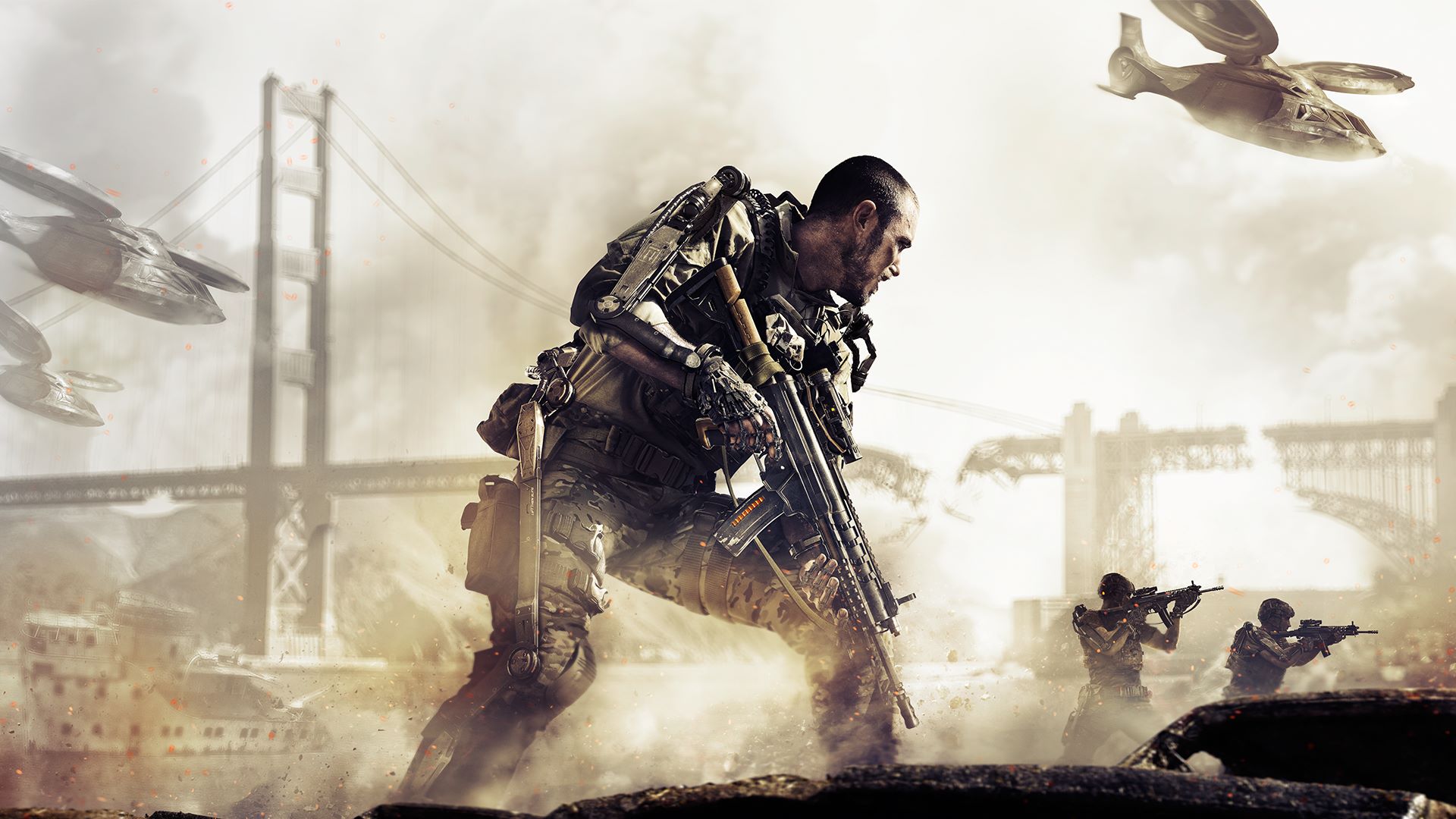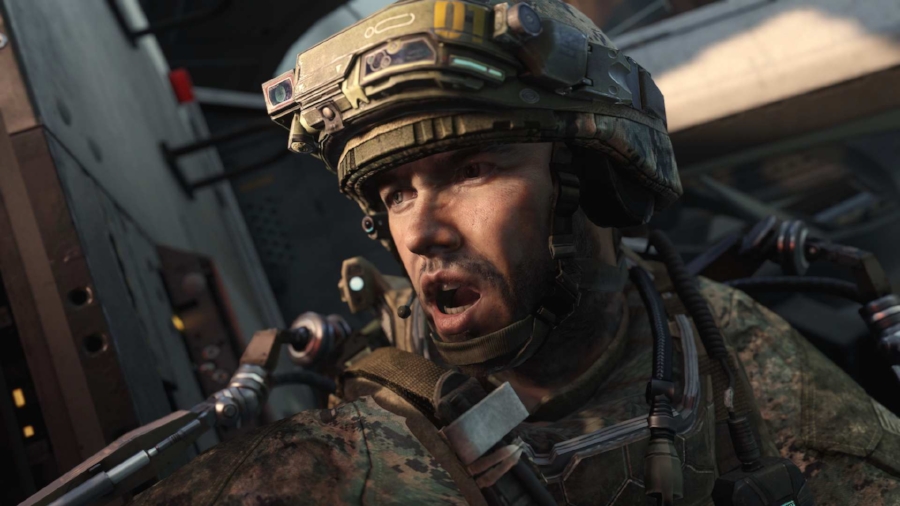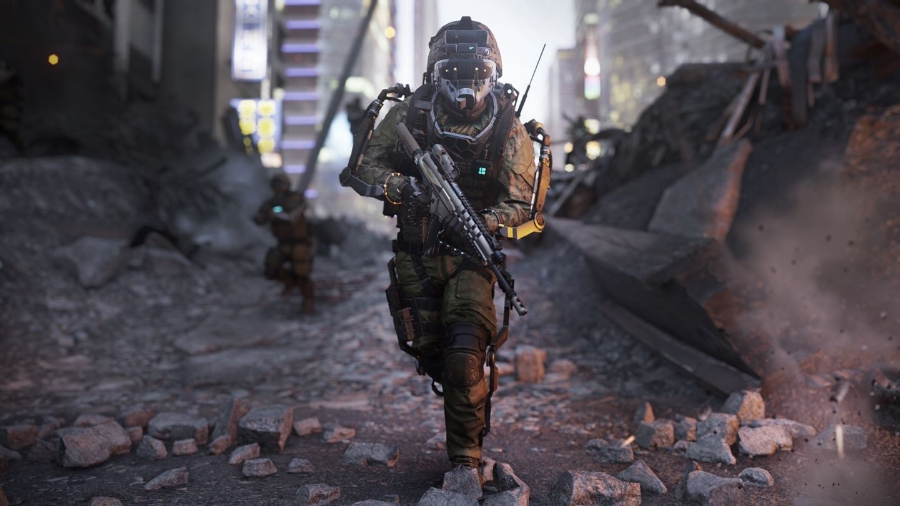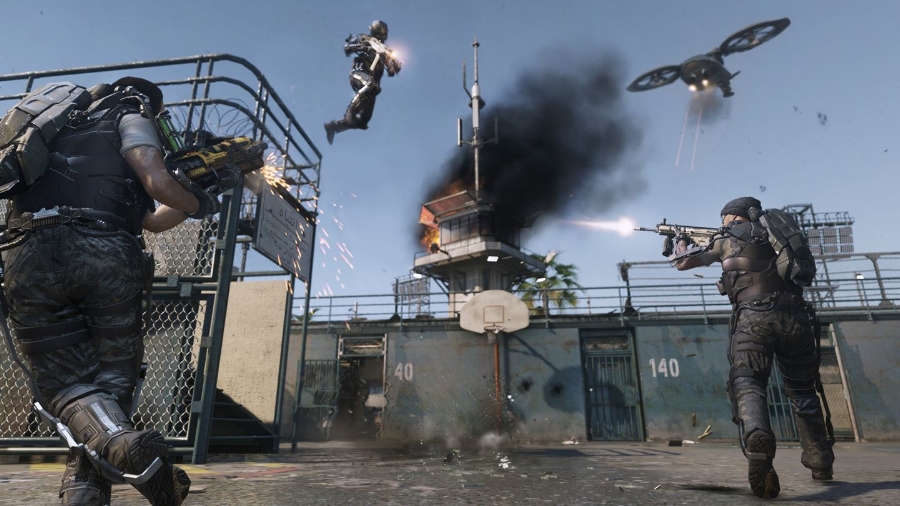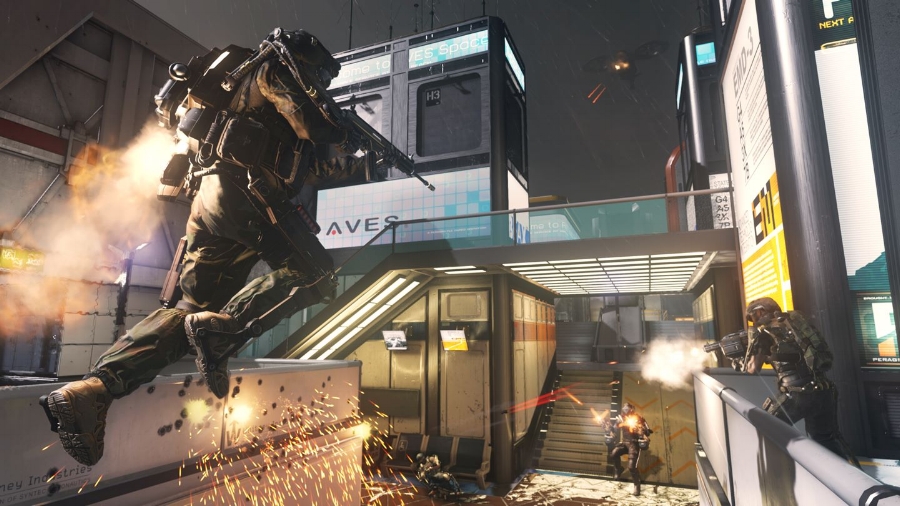Call of Duty: Advanced Warfare (2014)
The same, but better, and familiar…
Sledgehammer Games’ debut as the sole developer on a Call of Duty title excels in some areas, but owes other ‘advancements’ to recent competition.
Developed by Sledgehammer Games
Published by Activision
Released on Xbox One (played), PlayStation 4, PC, Xbox 360, PlayStation 3
Probably one of video gaming’s biggest intellectual properties, Call of Duty is a massive first-person shooter series that has consistently attracted top-tier development talent to create memorable and action-packed experiences. It’s pretty easy to see, though, that the franchise that is now 11 games deep may start to look pretty unimpressive after a while, just because there are only so many ways you can present a war-based shooter. As the series made the transition to new hardware with last year’s well-crafted yet overall unimpressive Call of Duty: Ghosts, some players may start to think that the franchise’s best days, and games, are behind us.
To that end, new series developer Sledgehammer Games – known for developing the exceedingly creepy Dead Spaceseries – have been added to the fold of the massive Call of Duty franchise, and have released their first effort with it: Call of Duty: Advanced Warfare. Unmistakably, this is a pure COD experience, as it brings the trademark production values, action, and sense of scale to its campaign, but Sledgehammer have also added to the formula with their own flourishes to make what may be the most refreshing Call of Duty game that we’ve seen in nearly a decade.
Preface
Before I actually dive into this review, I feel like its necessary for me to point out that I’m not exactly the biggest fan of this franchise. The result is that I haven’t played every game in this series, but I have played the vast majority of them. Call of Duty is an interesting series because of its vastly different settings. Early games focused on wars that have actually occurred, allowing you to be a part of historical real-world conflicts. More recent games, beginning with 2007′s Call of Duty 4: Modern Warfare, started to show the franchise dipping its toes into becoming looks into the future of warfare. Black Ops II was the first game set further out in the future, and a strong narrative and solid new gameplay mechanics made that one a recent standout in the series.
Still, out of all the ones I’ve played, my favorite remains the original Modern Warfare from 2007. The other campaigns I’ve played haven’t quite been as difficult or engrossing as that one, and the multiplayer element for MW1 also still stood as my favorite. Going into playing Advanced Warfare, I had a lot of preconceived notions about what it would be like, how the story would play out, and what the multiplayer mechanics would be like. Surprisingly enough, actually playing the game was an enlightening experience, in that it wasn’t what I expected. Let’s talk about why.
Presentation and Design
Right out of the gate, the thing that is most fetching about powering up Advanced Warfare for the first time is just how beautiful it is. While last month Alien: Isolation seemed to take the crown as the best looking game of 2014, that title now firmly belongs to the latest Call of Duty entry, since a solid resolution of 1080p and a smooth 60fps frame-rate are complimented by a plethora of visual flourishes in the environments, killer sound design that takes full advantage of a surround system, spectral and occluded lighting effects, and good old-fashioned solid performances. If you’re looking for a game that can flex the muscle and fulfill the promise of your new-gen console, Advanced Warfare is definitely the game to do it.
Probably the single most impressive aspect of an already very impressive presentation is the character models and animations. Pre-release behind the scenes materials have shown an incredible amount of effort placed on motion capture technology as well as facial capture, with actors providing both voices and performances for their respective roles in the game. This, coupled with environments filled with incredible lighting effects and detailed environments, makes for perhaps the most realistic-looking video game on the market today, which is saying something considering the somewhat fantastical futuristic technologies that are granted by the time period in which it takes place.
The end result of this realism, particularly as far as the rather incredible facial animations are concerned, is that it gives you a surprising amount of investment in the characters at play. As impressive as the facial and character animations are in the actual gameplay engine, they’re absolutely modern movie quality for the cinematic cutscenes. It creates a downright surprising level of immersion in the events of the narrative, and I continually found myself stopping with amazement at the mere thought that this is what video games look and sound like now.
Still, there were some minor issues. In some of the levels, the quality and precision of the in-game models’ lip-synching to their dialogue was off in several places, which takes you out of the experience pretty quickly. It’s weird, because some moments of in-engine dialogue showed a great quality to the lip-synch, but in other levels where the models weren’t the thing you’re necessarily focused on, looking at them shows that lip-synch quality drops off kind of dramatically. This is a minor issue in the larger scheme of the technology in play, though, and overall the design and presentation of Advanced Warfare is the best we’ve seen from the video games of 2014.
But in the end, that technology is meaningless if it isn’t bolstered by an engaging story and solid gameplay, which is the true test of any single player campaign.
Story and Single Player Gameplay
Call of Duty: Advanced Warfare‘s single player campaign begins the furthest ahead in time when compared to other futuristic entries, taking place in the year 2054. Powerful exoskeletal suits, or simply “exos,” are the norm for modern soldiers, with augmented strength, speed, and maneuverability making for a much faster and more intense vision of warfare. The player character, United States Marine Private Jack Mitchell (played by video game superstar Troy Baker), begins his story under the command of Sergeant Cormack, and serving alongside his best friend Will Irons. Mitchell, Cormack, and Irons are deployed into Seoul, South Korea in the midst of an attack on that country perpetrated by the Democratic People’s Republic of Korea (aka North Korea, or DPRK).
As Mitchell and Irons make a final effort to repel the forces from Pyongyang, an accident causes Irons’ death, and causes Mitchell to lose his left arm. Mitchell is then discharged from military service due to his injuries, and at the funeral for Will, Will’s father Jonathan Irons (Kevin Spacey), CEO of the powerful corporation and private military force the Atlas Corporation, offers to hire Mitchell as their newest recruit. As a reward for joining him, Irons’ company outfits Mitchell with an extraordinarily expensive and advanced cybernetic arm.
Not long after Mitchell joins up with Atlas, a terrorist organization known as the KVA begins perpetrating really devastating terrorist attacks against many different western governments. Since by this time the largest standing military in the world belongs to Irons and Atlas, the world turns to him for protection. Mitchell and his new mentor and partner Gideon (played by Gideon Emery) begin a series of operations around the globe to try and dismantle the KVA and stop these senseless attacks. As they’ll soon find out, though, the real enemy has yet to be discovered, and presents a far greater threat to the stability of the world than any terrorist ever could.
While the single player campaigns in the majority of Call of Duty games have a reputation as being even more bombastic and mind-numbing than even the most explosive-ridden Michael Bay film, Advanced Warfare comes as a bit of a pleasant surprise. Sure, the centerpieces of each major beat in the story are punctuated by some fantastic-looking explosions and some harsh scenes of violence, but the anchor of the story comes in the relationship between your player character, Mitchell, and Kevin Spacey’s character of Jonathan Irons.
Spacey brings his dedication to the acting craft with him and, unlike Peter Dinklage’s turn in this year’s Destiny, feels very authentic, energetic, and appropriately menacing as Jonathan Irons. If I have any major criticism of the character and of Spacey, it seems just a tad too close to the overall characterization of Spacey’s character in “House of Cards,” Frank Underwood. Irons and Underwood seem to share a very similarly pessimistic outlook on the overall effectiveness of the political process as well as a reverence for power, but each goes about acquiring that power a bit differently.
The narrative also represents a shift away from the norm of the series by having only one player character through the entirety of the story. In previous Call of Duty games, it wouldn’t be surprising for the player to get behind the eyes of up to a half a dozen characters over the course of one game. By focusing only on the character of Mitchell, it manages to stay much more focused and gets very close to actually being a compelling character piece.
It falls short, though, because every COD developer has continued to insist that having a player character speak over the course of the story would somehow dampen the player’s ability to place themselves in the proverbial shoes of the story’s events. I personally don’t buy that conclusion. For the first three entries of the Halo series, for instance, Bungie took the same approach with the Master Chief: he rarely spoke except for a few instances, which made for a rather impersonal experience of engagement with the sweeping events of the first games’ respective stories.
When Halo 4 was released at the hands of a new developer, though, a different approach was taken, and Chief actually engaged with the story far more than he had previously. To me and many others, that actually enhanced the narrative experience of Halo 4, and while Advanced Warfare is on the right track with a single character of focus, it manages to fall short because in the end it’s still a largely impersonal experience. Especially during moments where you might feel that anybody would be compelled to say something after witnessing certain events that take place.
From a difficulty perspective, the Advanced Warfare campaign isn’t that hard. Although it adds a plethora of new devices like grenades that can reveal the locations of enemies, Titanfall-esque jump kits that allow you to reach high levels, and some really imaginative futuristic weaponry, even playing this campaign on “Veteran” difficulty, the hardest setting, was only modestly difficult when compared to the now classic original Modern Warfare game.
Overall, though, Advanced Warfare features an engaging story, a solid step in the right direction from a character perspective, some truly great performances by the actors, and some solid and varied level design with typical running and gunning broken up with some welcome stealth and infiltration missions. Still, though, most people that buy Advanced Warfare will do so for only one thing: multiplayer.
Multiplayer Gameplay
When it comes to the centerpiece of the gameplay experience, one primary thought comes to mind: this is definitely Call of Duty. If you have any history with playing this series online, the actual feeling of gameplay and the overall community that comes with it hasn’t really changed all that much over the course of the 11 main games in the series. Although Sledgehammer Games have obviously put a lot of thought and energy into the structure of online multiplayer in this entry of the series, likely the most defining factor of that experience will be the community. Because of that, sometimes COD can be a little toxic.
For the veterans of the series who know all the old tricks from previous games, it won’t be out of the ordinary for you to be killed immediately after spawning, or to be picked off by someone wielding a sniper rifle floating on the far edges of the maps. If you’re not a seasoned player with this series, then chances are the online experience of playing Advanced Warfare will be a frustrating one.
Still, though, there are a lot of new additions here that make for an engaging and unique multiplayer experience in this game. Much like other recent entries, player customization is a big part of the experience, and Advanced Warfare is by far the most customizable entry of the series thus far. Everything from your physical appearance and outfits down to really specific loadout elements can be finely tailored to your play style. The only disappointing aspect of the customization in this game may be in specific weapon upgrades, which tend to feel a bit more marginal than they should. Even working very hard for a new attachment or ammunition type can be an arduous process, with only a slight amount of payoff to it.
The actual multiplayer maps, also similarly to Titanfall, definitely favor the high-ground. The exos that all players are equipped with make reaching that high ground paramount to you or your team’s success, and can definitely make for an overall different multiplayer experience. Unfortunately, this is hampered by a lot of the same.
While the game modes are certainly varied, there’s only one new one to speak of, which is a bit disappointing considering that this entry of the series is supposed to be the one that focuses on new generation experiences. What can I say? This is the new Call of Duty, and even though there are new elements to the multiplayer and will be fun if you like the series, it feels like the overall execution here is a bit more incremental than it is in the single player experience.
Overall
Call of Duty: Advanced Warfare is a good game. Visually, it’s jaw-dropping. It tells an interesting and surprisingly cautionary story. It features some solid new game mechanics, a compelling vision of the not-too-distant future, and a hard-hitting, visceral gameplay experience. In a way, though, it’s also caught in the web of a franchise that has gotten to be so massive that some of the freedom you’d hope a developer could have to cut loose seems a bit lost.
When you have the name Call of Duty on your box, then you have to be able to show people something that can easily be seen as the next iteration of a series that’s had ten games in the same franchise come before it. Still, Advanced Warfare is a step in the right direction, and a juggernaut this massive likely has to introduce more sweeping changes to the experience incrementally. There are times, though, where it feels a little too incremental.
You won’t find a better looking game this year, though, and full-HD resolution with a 60fps frame-rate coupled with truly breathtaking visuals and highly realistic facial and character animations definitely make this game a visual spectacle. It’s also an auditory spectacle as well, since the sounds of so many of the weapons can almost feel like they’ll be ringing in your ear if you shoot that rifle for too long.
There’s a piercing quality to the weapons, an impressive score to go behind them, and very solid performances by the actors involved. Technologically, Advanced Warfare is definitely the most well made entry in the series. If only they’d taken things just a little bit further…but since this is Call of Duty, one thing we can say for certain is that there’s always next year.
Score: 8/10
This review originally appeared on a website I served as senior editor.
A copy of this game was provided for reviewing purposes by representatives of Activision.

